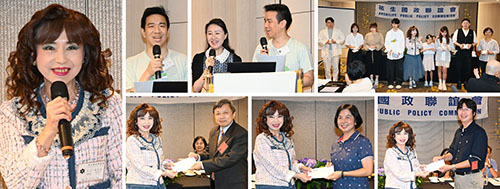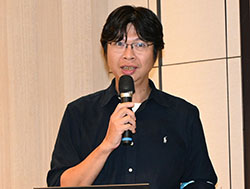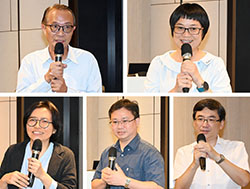
本會於2024年10月27日假台北喜來登大飯店地下一樓彩逸廳舉行「祐生國政聯誼會」。由主持人黃晉英秘書長宣布後揭開當日活動序幕,在輕鬆、活潑的節目之下,隨即由主持人帶來重要訊息:「11月份美國總統大選即將到來,選情陷入膠著狀態,也牽動世界局勢,而無論選舉結果為何,台灣都要有因應的策略,未雨綢繆。另外,賴清德總統在國慶日致辭中提到台灣與中國「互不隸屬」,引起國際討論。台灣因為是全球重要的半導體供應鏈,以及位處第一島鏈關鍵地緣位置,因此,維護台海和平穩定,為全球關注焦點。接著,近來公眾人物操守問題持續延燒,提醒大家勿被外在物質所迷惑,要兢兢業業,走向正確的道路!」
The October Archilife Public Policy Communion of 2024 was held on October 27, 2024. After a series of relaxing and fun activities, Secretary General Huang Chin-ying made the following announcement, "During the November presidential election in the United States, the election situation came to a halt, which had an impact on the global situation. Regardless of the election results, Taiwan should have contingency plans in place to deal with unforeseen circumstances. In addition, President Lai Ching-te stated in his National Day speech that the ROC and the PRC are "not subordinate to each other", sparking international debate. Taiwan is a major semiconductor supply chain in the world, and it is strategically located in the first island chain. As a result, maintaining peace and stability across the Taiwan Strait is a matter of global concern. The recent ethical controversy involving public figures is still spreading. Everyone is reminded not to be perplexed by external material, but rather to proceed conscientiously along the correct path!"

緊接著進行專題演講,由國政委員王文安先生主講「洄瀾宜居環境模擬管控」。主講人首先表示由於氣候變遷,使得建築隨之演進與改變。近期前進花蓮,也將因應氣候變遷的建築對策導入,包含微環境、韌性以及防災的解構思考。接著說明「花蓮縣都市設計基準研訂及微氣候環境分析」計畫目標為達成永續都市營造,透過 CFD微氣候環境模擬分析歷史文化、軸線、交通網絡、城市節點,觀測風、光、水、綠的狀態,加以運用在建築環境。主講人也說明當地六個都市高開發強度地區的環境模擬,重點在於要能減緩熱島效應及防風,建構宜居城市。
Next on the schedule was the keynote speech. First, Mr. Wang Wen-an presented a speech on the "Simulation Regulation of Huilan's Livable Environment". The speaker began by stating that climate change has caused buildings to evolve and change. In light of Hualien's recent advancement, building strategies in response to climate change have been introduced, including micro-environment, resilience, and disaster prevention-related deconstructive mindset. He then proceeded to explain "the formulation of Hualian County's urban design benchmarks and climate change analysis project objectives". They include creating sustainable cities, analyzing history, culture, traffic axis, transportation networks, city nodes using CFD microclimate environment simulation, and observing wind, light, water, and green status in the architectural environment. The speaker also explained the simulated current six cities, which are highly developed areas. The focus is on reducing the heat island effect and providing wind protection in order to build livable cities.

接著由國政委員顏秀慧小姐主講「環境權與氣候訴訟」。主講人首先表示世界經濟論壇中提到十年全球風險第一名為極端氣候事件,因此,全球因應氣候變遷的作為勢必要加緊腳步,包含制定氣候法律(與全球暖化相關的國際公約)、負擔氣候責任、採取氣候行動等。正由於氣候變遷,氣候訴訟也開始出現,當事人類型從國家、地方政府、企業到私人;內容特徵為與氣候變遷有關、具備科學不確定性及法律規範之界線有爭議;訴訟目的為保障人權、促進企業社會責任與環境社會治理及貫徹消費者保護。主講人也舉出美國、台灣及韓國氣候訴訟案例,其中韓國為憲法法庭判決,若以台灣憲法保障之生存權來看,會是新的思索方向。
Next, Ms. Yen Hsiu-hui spoke on "Environmental Rights and Climate Litigation". The speaker began by stating that extreme climate events were mentioned at the World Economic Forum as one of the most serious risks we might face over the next decade. As a result, practices in response to global climate change must be accelerated, such as establishing climate laws (the International Covenant related to global warming), accepting climate responsibilities, implementing climate actions, and so on. Climate litigation has arisen specifically as a result of climate change. The participants range from countries, local governments, businesses, and individuals; the content focuses on climate change, demonstrating scientific uncertainty and disputable boundaries of legal norms; the goal of the negotiations is to protect human rights, facilitate corporate social responsibility and environmental and social governance, and carry out consumer protection. The speaker also mentioned climate litigation cases in the United States, Taiwan, and South Korea. South Korea, in particular, follows the Korean Constitutional Court's ruling. It represents a shift in mindset in light of Taiwan’s right to survival under the protection of the Constitution.

接著由國政委員賴榮一先生主講「將藍碳融入都會公園之案例」。主講人首先表示本次講述的案例位於高雄市三民區中都濕地公園,在思考台灣因應氣候變遷下,都市公園進一步規劃可發揮調適功能,包含復育植物在大高雄環境發揮碳吸存功能、區域滯洪、都市降溫、排水系統、水質淨化以及棲地復育等多項目標。十年過去,本研究證實中都濕地紅樹林能夠提供高度的碳吸存能力,也突顯紅樹林存在的價值與生態系服務。中都濕地公園所形成的紅樹林生態系為高雄市的溫室氣體問題發揮「調適」功能,成為名符其實的「宜居城市」,這片持續成長的濕地及其發展經驗,必然成為我們明日共同的希望。
Next, Mr. Lai Jung-yi spoke on "Cases of the incorporation of Blue Carbon into Metropolitan Park". The speaker began by mentioning that the case in question is located at Jhongdou Wetlands Park in Sanmin District, Kaohsiung City. Given Taiwan response to climate change, the urban park has been further developed to include adaptation functions. They include plant restoration and carbon sequestration, regional flood retention, urban temperature reduction, drainage systems, water purification, habitat restoration, and a variety of other goals for Greater Kaohsiung. Ten years have passed, and this research has confirmed that the Jhongdou Wetlands Mangrove can provide a high level of carbon sequestration. This also demonstrates the value of the mangrove in terms of survival and ecosystem service. The mangrove ecosystem formed at Jhongdou Wetlands Park demonstrates the "adaptation" function in light of Kaohsiung City's greenhouse gas issues, making it a true "livable city". This wetland's continued growth, as well as the experience of its development will undoubtedly become a shared hope for us all in the future.

演講完畢,黃晉英秘書長代表基金會致贈謝禮予主講人。接著在與會者紛紛利用「餵豬時間」提出個人意見與看法交流後,圓滿地結束十月份國政聯誼會。
After the speech, Secretary General Huang Chin-ying presented a gift to the speakers on behalf of the foundation. Then, attendees expressed and exchanged their opinions and views during the piggy hour. The October Archilife Public Policy Communion ended smoothly.